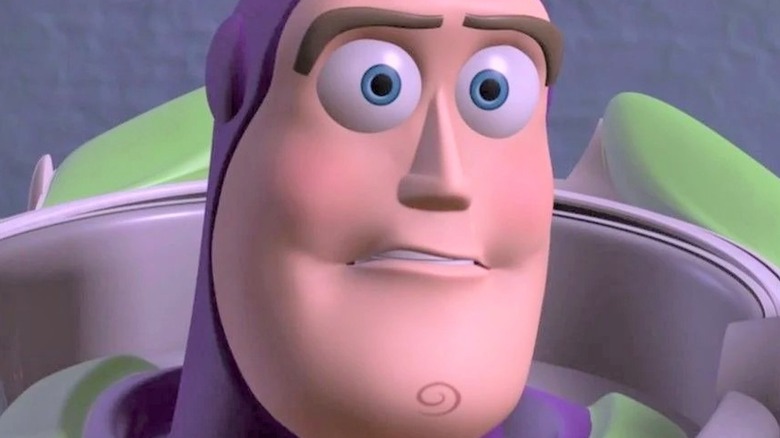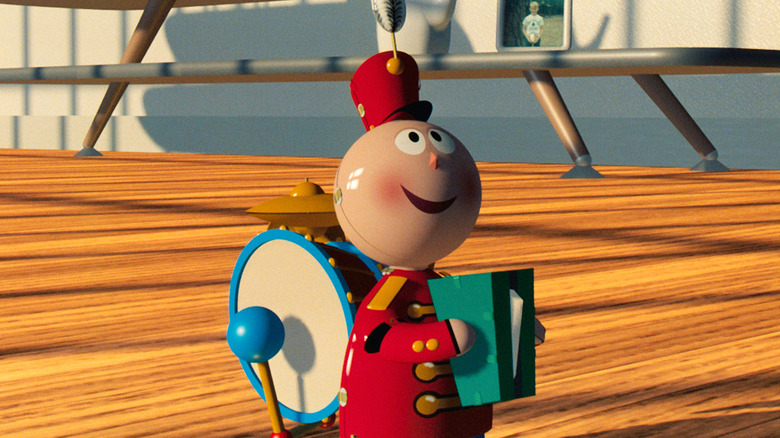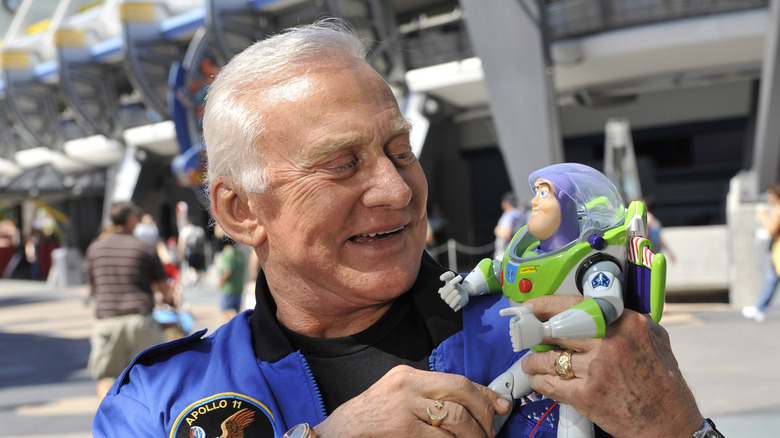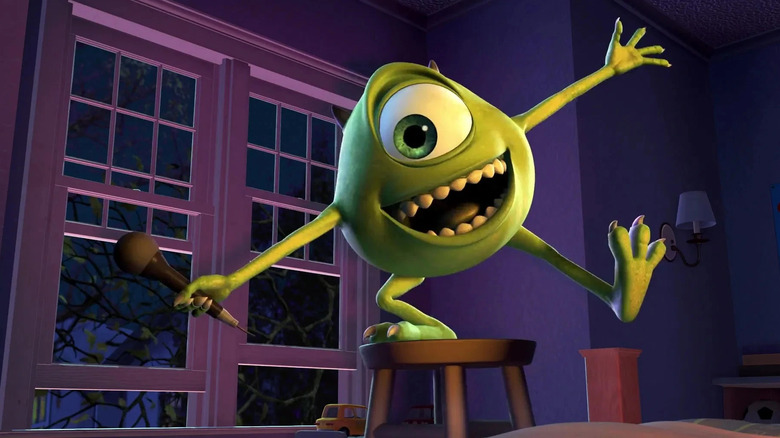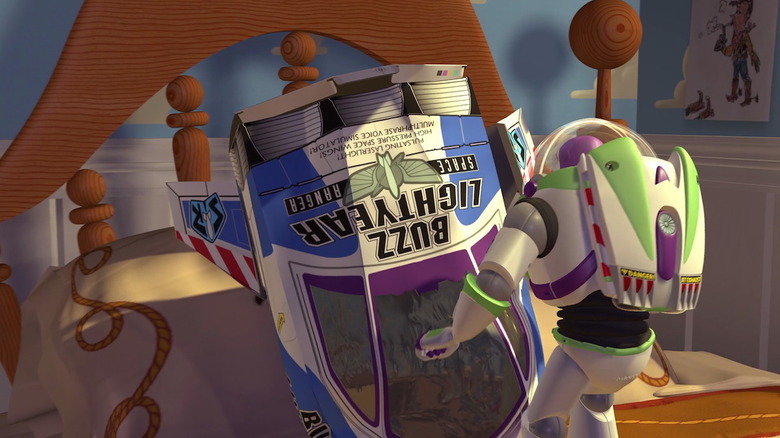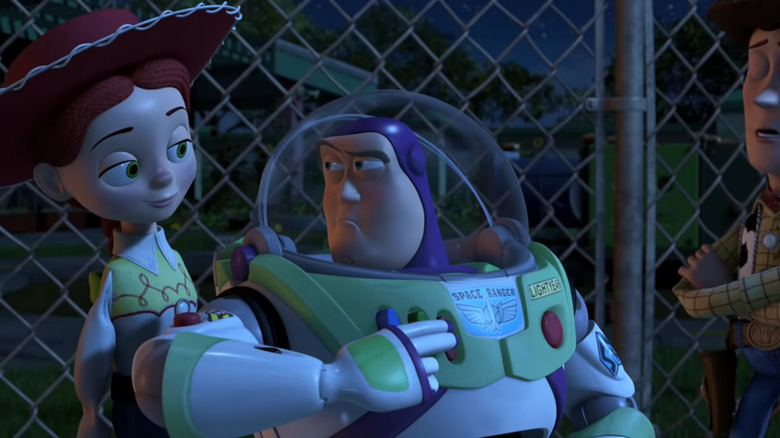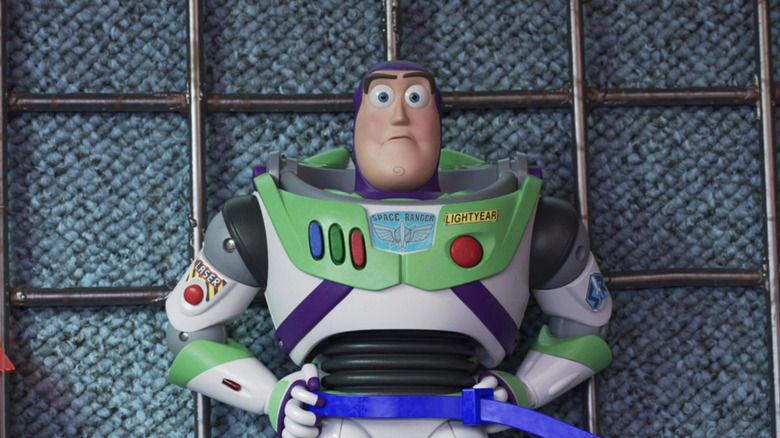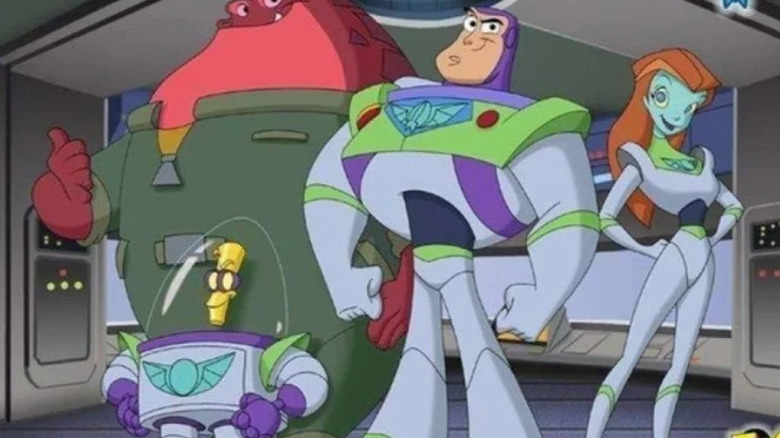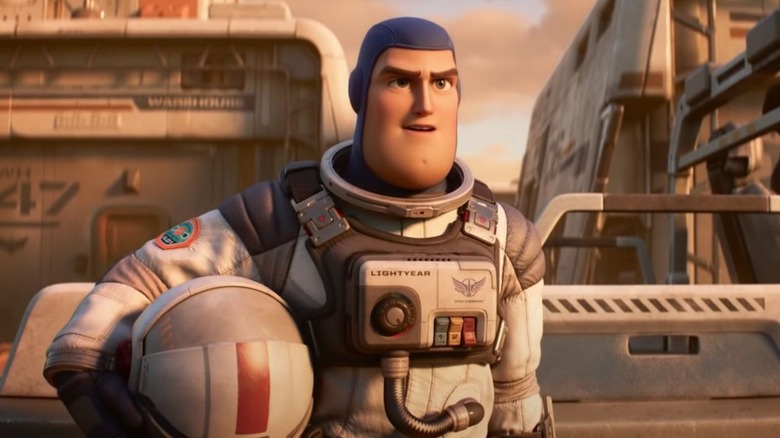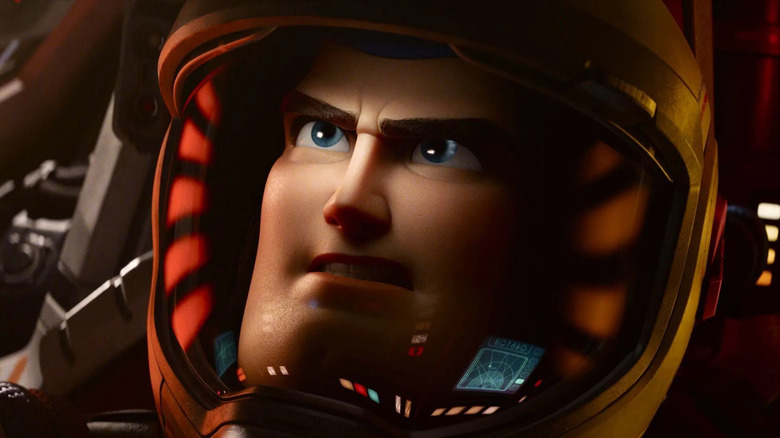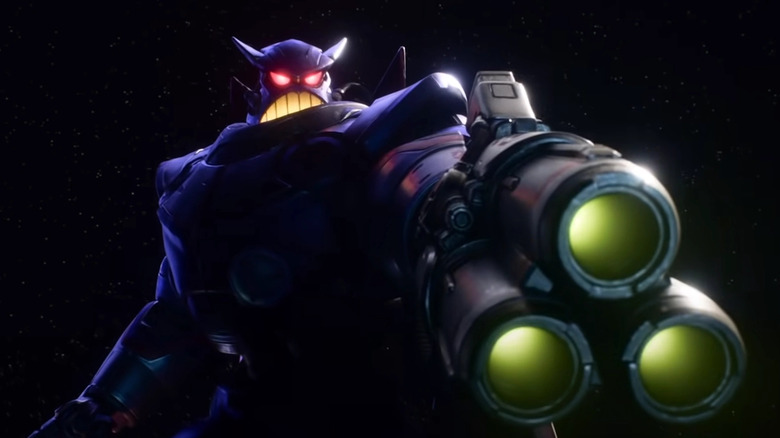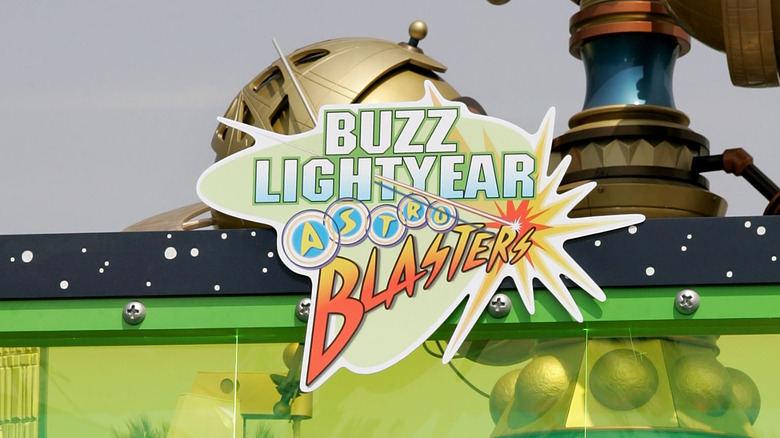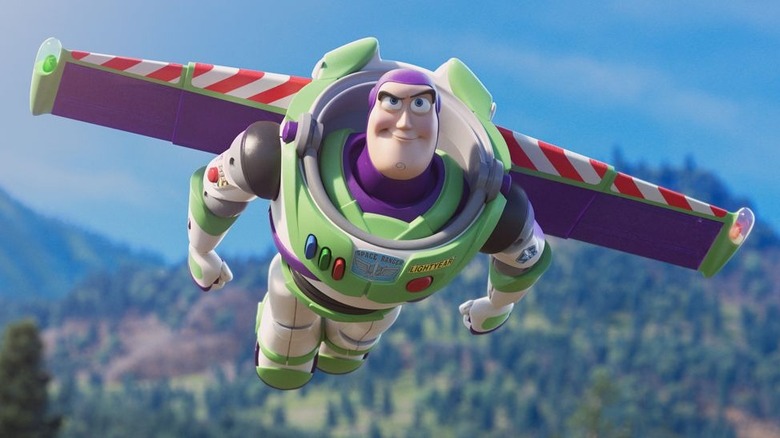The Untold Truth Of Buzz Lightyear
Buzz Lightyear is a difficult guy to define. He's a fictional space ranger and a fictional toy, but he's also become real merchandise thanks to the mega-success of the first-ever completely computer-animated feature-length film in which he stars, and a real space ranger in his ever-more-meta spin-offs. He's been the central character in five movies, a television series, holiday specials, video games, and even amusement park attractions. Along the way, the "Toy Story" character has been voiced by three famous actors and animated by some of the best in the business at Pixar. He captured audiences' hearts in part because he was designed to reflect modern pop culture (with just a dash of nostalgia) and a can-do attitude (with just a pinch of self-parody) that both kids and adults find likable and funny.
Most people met Buzz Lightyear when Andy got his very own Buzz action figure for his birthday in the 1995 film, but the Star Commander's origins date back years earlier. He charted a bumpy course from one of Pixar's earliest ideas to one of the world's most iconic characters, and not without some obstacles and controversies along the way. Had anything gone differently, it's possible that not just Buzz Lightyear but "Toy Story" or even Pixar wouldn't exist. This is the untold story of Buzz Lightyear — the toy, the Space Ranger, the man, and the people behind him — with all of its intergalactic (and entertainment industry) twists and turns.
He began life as a vintage toy
Back in 1988, when Pixar was a struggling tech company owned by Steve Jobs, John Lasseter and his team made a five-minute short film called "Tin Toy" that not only introduced most of the moviegoing public to computer animation, it also saved the studio from shutting down (per The Take). "Tin Toy" is about an old-fashioned one-man-band toy named Tinny, who is given to a baby named Billy. Unfortunately, to Tinny's horror, Billy's pretty rough on his playthings. The toy hides under the furniture, where he finds more terrified gadgets and gizmos. But being toys, Tinny and the others can't help themselves from comforting the crying baby, who's more into the packaging anyway.
As Tinny is the new toy introduced into the situation, he's the de facto lead character of "Tin Toy" and a stand-in for the character that became Buzz Lightyear. The short premiered at SIGGRAPH, a computer animation convention, 3/5 complete (per Flickering Myth), and was well-received enough to turn heads at Disney (per The Independent). The completed version went on to win the Oscar for Best Animated Short Film and helped Pixar secure the funding needed for "Toy Story," the company's first feature film. Lasseter, who grew up in the 1960s, had a fondness for vintage toys, but he realized that '90s kids might not be into one-man-band toy soldiers, so for his next act, the protagonist received some upgrades.
He's inspired by Buzz Aldrin
For the redesign, John Lasseter wanted something G.I. Joe-sized, and he wanted to pay tribute to the astronauts he says he idolized as a kid. The wind-up tin soldier musician evolved into a 12-inch space ranger action figure. Lasseter says he remembered feeling like the Apollo astronauts in their clear bubble helmets, skullcaps, and white suits were like real heroes without capes. The design team developed the new toy with those elements in mind, then added some bright colors and tricked-out, toyetic features.
Rough drafts of the name included Tempus of Morph and Lunar Larry (per Metro). The latter's initials can be seen in early sketches. However, the studio decided Lunar Larry sounded too silly, and besides, the filmmakers wanted to honor a man who'd actually been in space. In a "Toy Story 3" featurette, Lasseter explains the team thought the astronaut with the coolest name was Buzz Aldrin, the second person to walk on the moon, after Neil Armstrong. They took Aldrin's first name and the word "lightyear" (a unit of astronomical distance) for the surname to create their plastic spaceman's perfect moniker.
It seems Buzz Aldrin and Buzz Lightyear have a good working relationship, though Aldrin likes to remind Lightyear that he's the real Buzz. A Buzz Lightyear action figure spent 15 months on a real mission aboard the International Space Station. Upon his return to Earth, he and Buzz Aldrin were honored in a Disney World parade (per the astronaut's website).
Pixar wanted Billy Crystal to voice him
With the story and the character designs coming together, Pixar was ready to cast the voices of Woody and all of Andy's other toys. Tom Hanks lassoed the role of the pull-string cowboy, but producers originally wanted Billy Crystal for his space ranger nemesis-turned-friend (per Yahoo Entertainment). Lasseter was so convinced that Crystal had the right energy for Buzz that he created a CGI screen test with audio from the comedian's performance in "When Harry Met Sally." Crystal ultimately turned it down because he didn't think he was the right fit.
Pixar also considered Jim Carrey and Chevy Chase (via Vulture), but because of a combination of the actor's stand-up comedy (per Bustle) plus great chemistry with Hanks, Tim Allen was offered the job. Though Crystal regrets turning down what became one of the most legendary and lucrative roles and films of all time, calling himself the "the schmuck who turned down 'Toy Story,'" he thinks they ultimately made the best choice (per Yahoo Entertainment). "Tim Allen is great," he told Yahoo Entertainment. "He has this resonant, big voice of this character who's full of himself."
The actor didn't have to pine for Pixar for too long. The animation studio gave Crystal another chance in a new film they began developing the year after "Toy Story" opened. Crystal went on to voice Mike Wazowski — the little, round, green monster — in 2001's "Monsters, Inc." and 2013's "Monsters University" alongside John Goodman's Sully.
He doesn't realize he's a toy
In the final stages of pre-production, filmmakers were still struggling with the script. Joss Whedon was brought on to offer some insights, initially for three weeks, but that turned into six months (per Insider). Whedon understood that John Lasseter's "concept was gold" but found the working screenplay to be in "shambles." The draft he inherited contained several bits that still found their way into the movie — there was a gas station scene, a vicious kid who's sadistic to toys, and tension between Andy's two favorites — but things needed some tweaking. While Woody just needed to be less scary (he was originally a mean ventriloquist puppet), Buzz Lightyear presented more of a problem.
As it stood, he was written as a "Dudley Do-Right" type, simply a modern counterpoint to Woody, which made Andy's old favorite toy feel insecure (via Insider). However, the space ranger's level of self-awareness wasn't working, and the overall story needed more of a hook. Whedon changed everything by imagining Buzz as a toy who didn't realize he was a toy and took his job with Star Command extremely seriously. That not only gave Buzz more character development, but it also created more conflict and contrast with Woody, who cares deeply about being a good toy. Buzz's straight-faced but misguided belief in himself also provided comic relief and an emotional climax when the astronaut action figure finds out the truth.
He falls in love with Jessie
Once "Toy Story" proved CGI could wow audiences with a massive box office haul, Pixar began developing a sequel. At this time, most animated sequels went straight to VHS or DVD, and "Toy Story 2" was expected to be made as a direct-to-video property, but some Pixar creatives didn't want the studio to burn its reputation on a lesser product. "Toy Story 2" was a notoriously troubled production, but now it's widely regarded as one of the best sequels and best animated films of all time. Part of its appeal was its new protagonist, Jessie (Joan Cusack).
Lasseter's wife, Nancy, pressed him to include a more dynamic female character in the follow-up than Bo Peep had been in the original (per The New York Times), so writers Lasseter, Pete Docter, Ash Brannon, and Andrew Stanton imagined cowgirl companion for Woody who would be part of a vintage set. Jessie is strong, adventurous, and loyal — all qualities "Toy Story" fans found endearing. In the film, Buzz Lightyear finds them endearing, too. While it would've been easy (and expected) to pair her up with Woody, the filmmakers made the inspired choice to have the space ranger fall for Jessie. In "Toy Story 3," the two share a romantic Spanish dance together, and Jessie tells a hilariously smitten Buzz that he's the sweetest space toy she's ever met. Though their relationship is only hinted at, it's clear they're still together at the end of "Toy Story 4."
Sequels struggled to figure out what to do with him
Two more "Toy Story" films — 2010's "Toy Story 3" and 2019's "Toy Story 4" — went on to become even bigger hits, but Buzz Lightyear — the one-time co-lead — has a smaller role in the third installment and a much-diminished role in the fourth. While rumors suggest this has to do with Tim Allen's politics, the fault really lies in the character's arc being largely resolved in the first movie. In "Toy Story 2," Buzz leads a rescue mission to save Woody, but by "Toy Story 3," he's switched into demo mode and brainwashed by the villainous Lotso. Andy's toys accidentally switch on Spanish mode, turning Buzz into a Latin lover who woos Jessie.
Buzz's screentime and importance are both drastically reduced in "Toy Story 4," in which the character's only real bit is that he believes his preprogrammed catchphrases are his conscience guiding him. While these set pieces are funny enough, they don't do much to advance Buzz Lightyear as a character. In fact, in a way, each movie after the original resorts to what wasn't working about Buzz before Joss Whedon intervened. He becomes a punchline, and the repetitive joke is that he's good-hearted but not very smart (as argued in Collider). Meanwhile, Woody — whose internal journey is a metaphor for accepting the aging process and the passage of time — is key to the franchise's themes throughout and thus becomes "Toy Story's" primary protagonist.
Patrick Warburton voices him in a TV series
In 2000, Walt Disney Television Animation and Pixar developed a 2D animated series called "Buzz Lightyear of Star Command." It ran for 62 episodes between 2000 and 2001 in syndication on Disney Channel and Toon Disney until 2009 (per Collider). In the "Toy Story" movies, Buzz's plots are constrained by the fact that he's Andy's toy, but in "Buzz Lightyear of Star Command," the fictional character is a space ranger, serving Star Command on behalf of the Galactic Alliance, keeping planets safe from hostile aliens, especially the evil Emperor Zurg and his robots. In other words — as the opening credits reveal when the "Toy Story" toys gather in front of the TV — this is the Saturday morning cartoon about Buzz that Andy would've watched.
Patrick Warburton voices the 2D Buzz, and his fellow "Seinfeld" alum Wayne Knight voices Emperor Zurg. Warburton, an accomplished voice actor, is well-known for his incredibly deep register, but his Buzz Lightyear sounds like a cross between Tim Allen's action figure and William Shatner's Captain Kirk. "Buzz Lightyear of Star Command" is, in concept, pretty similar to "Star Trek," taking place in a distant future during a time of relative peace, and Buzz heads a diverse crew charged with carrying out weekly missions. Though the villains vary from episode to episode, Zurg is behind most of them, which becomes a running joke. A video game adaptation was released by Activision to accompany the series.
Lightyear is the movie Andy would've seen
If "Buzz Lightyear of Star Command" is the goofy Saturday morning cartoon Andy would've watched, then "Lightyear" — Pixar's much glossier 2022 film — is the blockbuster he would've seen that would've started the "Buzz Lightyear" franchise in his world. If you're confused, "Lightyear" begins with an open crawl that reads, per The AV Club, "In 1995 Andy got a toy. That toy is from his favorite movie. This is that movie."
"Lightyear" is rendered in gorgeous modern CGI with a more serious tone and grander scale, supporting the idea that this film would've been a big deal in Andy's universe. It's also full of Easter eggs and references to "Toy Story" that — in this meta, in-world franchise — would've theoretically come first. Since Andy is CGI, we're left to assume that "Lightyear" is probably meant to be live-action, as the groundbreaking "Toy Story" came out the same year mentioned in the crawl. If so, Buzz is basically Andy's version of Luke Skywalker. That explains why the character, his spacesuit, his gear, his ship, and the planet he's on look more photorealistic. Further complicating matters, director Angus MacLane told Inverse he imagined Andy might've seen "Lightyear" on VHS sometime between 1980 and 1990.
Even if you understand the basic idea behind "Lightyear," that's a lot to wrap your brain around. A simpler way to look at it is that filmmakers just wanted to make a really cool sci-fi movie starring a character they already loved.
Chris Evans was chosen to be the real Buzz Lightyear
When "Lightyear" was announced, news also broke that Chris Evans, not Tim Allen, would be playing the title role. Some fans took to the internet to criticize Disney for, in their view, replacing Allen, who voices Buzz in all four "Toy Story" films and a handful of holiday specials (per Epic Stream). However, since "Lightyear" isn't really a "Toy Story" movie but a Buzz Lightyear "sidequel" (per Yahoo Entertainment), director Angus MacLane felt justified in going in a different direction. He told Fandango that Evans was the only actor he considered for the role of the "real" Buzz because of his "gravitas and star power."
MacLane envisioned his Buzz as an actual person instead of a toy, and he thought Evans could convey "straight-laced classic movie hero" while also subverting that when necessary (per Fandango). He worried that the idea could easily turn into mockery, and he wanted "Lightyear" to feel like an inspirational love letter to science fiction. The studio pitched Evans the idea, and Evans — who is a fan of animation and of Pixar in particular — was quick to sign on (per Fandango). Evans' Buzz sounds like a less, well, animated version of the character, but there's definitely a hint of homage to Allen in his performance. The new voice of Buzz also made sure to credit the man who came before him, telling fans (per The Independent), "What Tim Allen did was pretty untouchable."
The spin-off breaks previously established canon
So far, "Lightyear" has been a respectable if not earth-shattering hit with critics and audiences, but for fans who are bothered by such things, this new Buzz Lightyear story makes a mess of previous canon. The plot of "Lightyear" diverges from "Buzz Lightyear in Star Command," and the film's big twist contradicts the "Toy Story" movies.
In "Lightyear," Buzz and his commanding officer and best friend, Alisha Hawthorne, explore a potentially habitable planet, T'Kani Prime. When they learn it's home to dangerous lifeforms, Buzz damages their "turnip" ship during their escape, and his crew is forced to set up a colony until they can find a way home. Buzz experiments with hyperspace fuel crystals in hopes of fixing his mistake. But with every test flight (because of time dilation), his coworkers age years while he's only in the air for seconds. Spoilers — Alisha marries, has a kid, then a grandkid, then dies before Buzz can figure out their fuel problem. Once he and his electronic pet cat figure out the solution 62 years later, T'Kani Prime is under attack by Zurg and his practically undefeatable robot horde.
"Lightyear" contradicts the animated show with a new mission and a new crew. But Zurg is another matter. In "Toy Story 2," it's revealed that Zurg is actually Buzz's absent father in an obvious nod to "The Empire Strikes Back." In "Lightyear," Zurg is an angry, elderly Buzz from the future who wants to use hyperspace crystals to go back in time, which would erase our Buzz's friends from existence.
He has his own Disney ride
You could say you've made it when you see your name on a marquee, and even better if you can find a toy made in your likeness on store shelves. But very few people or characters get a whole amusement ride devoted to their persona. Buzz Lightyear can boast six rides named after him — one for every Disney theme park in the world (per WDW News Today). The rides share the same design and provide the same experience, though there are slight variations in their titles.
The first to open was Buzz Lightyear's Space Ranger Spin in Walt Disney World's Magic Kingdom, which debuted in 1998. Guests ride in XP-37 Space Cruisers outfitted with laser guns and go through 13 simulations, scoring points for defeating Zurg and his minions. Disneyland welcomed its own version, called Buzz Lightyear Astro Blasters, in 2005 (per Inside the Magic). There are also Buzz Lightyear rides in Tokyo, Paris, Shanghai, and Hong Kong, though the latter attraction closed in 2017 to make room for an "Ant-Man" ride.
The experience is part-dark ride, part-giant arcade, so it's popular with Disney visitors of all ages and thrill levels. A picture of riders is snapped at the end that includes their final scores. With the release of "Lightyear," rumors are beginning to swirl that these now slightly outdated attractions could soon get a makeover (per Theme Park Tourist). The character also appears in parades and as a character meet-and-greet in Disney Parks.
He was Pixar's most popular character and top-selling toy
Since 1995's "Toy Story," Pixar has brought to life more than a few characters who have become modern classics, but Buzz continues to be one of audiences' favorites. In 2007, readers of Empire Magazine voted him their top choice for best Pixar character. Rolling Stone ranked him 10th on a more recent list in 2020 (at which point Pixar's named characters numbered well into the hundreds). He made the final two of The Ringer's fan-voted Pixar bracket that coincided with "Lightyear's" release, where he was defeated by his co-star, Woody. And he's one of only two Pixar stars who've been given their own theatrically released spin-off movies (the other is Dory).
It's ironic that the year "Toy Story" came to theaters, toy makers underestimated Buzz's popularity and didn't produce enough action figures to meet that holiday season's demand (per Marketing Week). The miscalculation cost Mattel and Disney millions of dollars, as Buzz Lightyear toys — the top-selling toy that Christmas — sold on the secondary market for huge markups. They didn't make that mistake again. Buzz Lightyear products have remained in demand ever since (via the BBC), with kids and adults alike, who keep shelling out big bucks for green and purple paraphernalia. From ticket sales to T-shirts, Buzz Lightyear's influence really does go to infinity and beyond.
